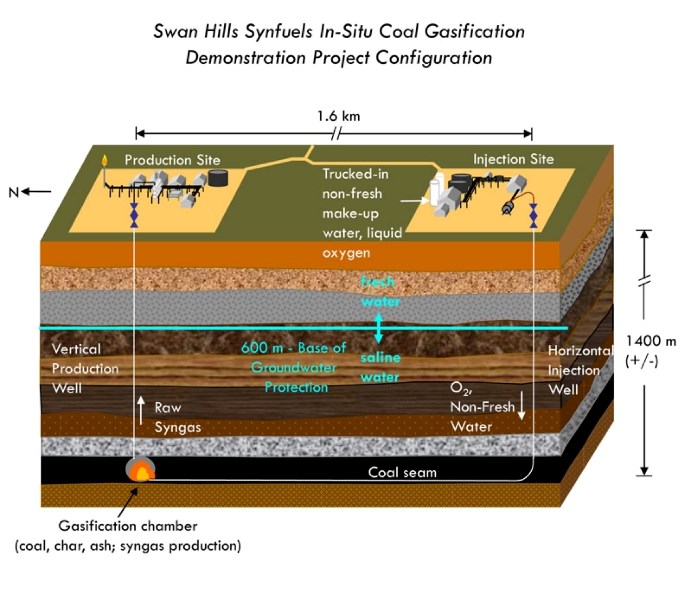The Alberta government is spending $285 million to help a new power plant that will provide energy to 300,000 homes while sequestering 1.3-million tonnes of carbon dioxide (CO2) underground get up and running
Energy minister Ron Liepert announced funding for the Swan Hills Synfuels project on Wednesday, which he said is part of the government's commitment to carbon capture and sequestration (CCS).
"We know the world is watching our progress on CCS. We also know many jurisdictions talk about the importance of CCS, but to be honest very few have really done anything about it."
The project will inject steam and brackish water into an untapped coal seam that is nearly a mile below the surface. The process will gasify the coal, allowing it to come up to the surface, where a processing plant will remove the CO2.
The now-cleaner burning synthetic gas will then be used to generate electricity while the CO2 will be sequestered underground in abandoned oil wells, which will help extract more oil from them.
In total, the company is expecting the project to cost $1.5 billion and be up and running in 2015. The government's share will be contributed in stages with 40 per cent initially, 20 per cent after commercial start-up and the remaining 40 per cent over the next 15 years.
Company CEO Martin Lambert said the plant represents new technology and has a huge potential to tap coal in Alberta.
"It will create a significant new industry for the province of Alberta and will also, we believe, make a meaningful contribution to the global knowledge and experience base."
The power plant at the site will still have a carbon footprint, but the company estimates it will be two-thirds lower than traditional coal-fired power plants and comparable or better to natural gas.
Liepert said the province still needs energy and the new plant will help offset regular coal plants, providing the same energy without the CO2.
"You can look at it as new CO2, I look at it as CO2 that is replacing the current CO2 that is coming out of coal and we have to find a replacement for that coal."
Liepert said the government's carbon capture program helps reduce carbon outputs and helps encourage new technologies.
"There is a lot of proving out of technology and that was part of the $2-billion commitment to advance technology."
Lambert said future stages the company would like to pursue won't need government funding, but this is the first out of the gate.
"The investors in the first project see greater risk and want greater reward."
The provincial government estimates there is 37 billion tonnes of coal in the province that is mineable from the surface. Lambert said beyond that reserve is the amount of coal that could be accessed through this method, which he said even the most conservative estimates put at 620 billion tonnes.
Welcome investment
Municipal leaders in the area also welcomed the government's announcement, expecting to see more jobs and investment in the area.
Whitecourt Mayor Trevor Thain said this first project could pave the way for a huge new industry.
"If this become a very viable project, with that in-situ coal seam that is down there, there are like 36 townships of this coal under the ground. This project is going to use up five square miles."
Woodlands County Mayor Jim Rennie said the county expects the project will eventually represent about 10 per cent of property taxes and provide between 80 and 100 permanent jobs along with hundreds more in the construction phase.
"There is just a line-up of wins on this and we don't see any downsides," said Rennie.
Wrong direction
Chelsea Flook, a spokesperson for Sierra Club Prairie, an environmental group said the entire carbon capture program is the wrong direction.
"Alberta stands alone. A lot of other jurisdictions in Canada are creating policies to spur the deployment of renewable energy and Alberta prefers to keep us locked into dirty energy."
Flook said the Alberta government is intervening in the energy market with this program, but won't create similar programs for renewable energy.
"If there is a $2-billion fund for carbon capture and storage then that is a distortion of the market that directly benefits oil and gas."
Carbon Capture Projects
The government's carbon capture program is funding a total of four projects at a cost of $2 billion.
Alberta Carbon Trunk Line $495 million
Quest Project $795 million
Swan Hills Synfuels $285 million
Project Pioneer $436 million (negotiations not complete)




